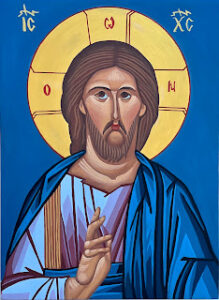by Alexandra Velickovic
Having most recently been invited to participate in a CLM teleconference on Faith, Hope and Presence (listen here), I’ve been contemplating the inextricability of the deeper meaning of these words for some time. I had mentioned on the call that for ‘faith” I find that the word ‘trust’ is a more true fit for me and for ‘hope’ I use the word ‘intention’. Ultimately, with presence, I’m finding that these words inspire immersion into a mystical space.
I was recently in Sacramento, California, at a six day Byzantine iconography painting course. It has been a time I set aside as a retreat for myself every year to be immersed in an intentional artistic creation space. This year Jesus was the subject and while I was there, painting for close to eight hours every day, my intention was that the icon create itself through me, through my eyes and my hands. It was really profound to be a channel for this image and notice the state of trust, intention and presence I was to be in for it to come through. In my experience, an icon can be an entrance into the space of creation for one who chooses to attune to it. I find that the Byzantine style of painting itself isn’t particularly one of visual depth but that is the very point. Just as the space of creation doesn’t pull or draw you in, despite being inherent in all things, it is still up to us to be in our awareness of it and choose it. The creation space is there for all who hold an intention to be present to it and its infinite qualities.
In my deeper inner work, I find myself with a committed intention of accessing this unknown space, resting in it, living it, breathing it, becoming it. I also find that it’s not really a very comfortable awareness and I don’t recognize myself as a connoisseur whatsoever. Parts of my day will pass and it’s as though I have amnesia about it even though I’m simultaneously inseparable from it. I’ve seen many paths offering references to the space of creation in their scripture and again I find that some of the terms resonate with me and others less so. To define it is to limit it and so then how can it be described? In his book, Writing in the Sand, Jesus and the Soul of the Gospels, Thomas Moore uses a well-known Christian term, ‘the kingdom’. I may not be partial to this term but I find that the author offers some words that I found potent in my own awareness of this space:
‘The kingdom, too, is like an open window, nothing in itself, and yet it allows everything. It is transparent and translucent. It allows the fullness of life to shine through. It is a way of seeing and living, but it is not an entity separate from ordinary existence. It is not a set of beliefs as much as a slant on life. In some ways it’s a door opening to a new life, but even better, it’s a window you can look through and see another world.’ (page 6).
My experience with this quote is that it resonates in me with a freshness, compassion, freedom, grace and the indestructible and infinite quality of the space of creation. In these words I hear the author presenting it as a vibration and an energy. He also goes on to say,
“When you look for the kingdom in a person, you don’t look for special clothes or particular words coming out of his mouth. The kingdom is invisible, empty. It’s more like a color than an object, more like a sound than a structure. It isn’t anything more than a point of view, but it is a perspective on life that makes all the difference.”
(Writing in the Sand, Jesus and the Soul of the Gospels, by Thomas Moore, page 6).
In my understanding, these words point to a certain subtle resonance of beingness which carries the space of infinite possibility. As much as the qualities of this space may or may not be conveyed and the experience of it may be subjective, I am deeply grateful for the creative experience during the painting process of my icon and for the energetic remembrance that has lead me deeper with the infinite creation.

